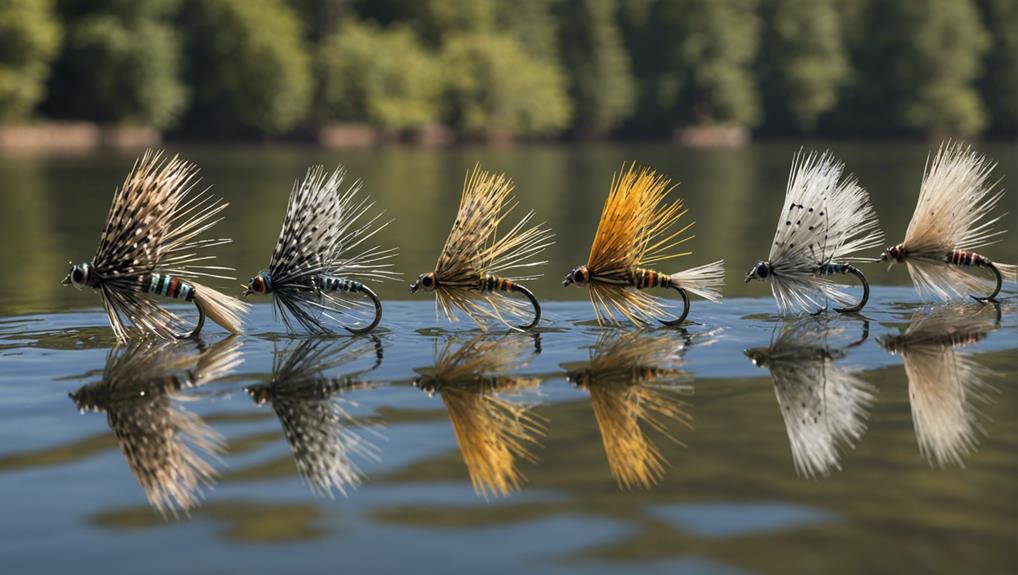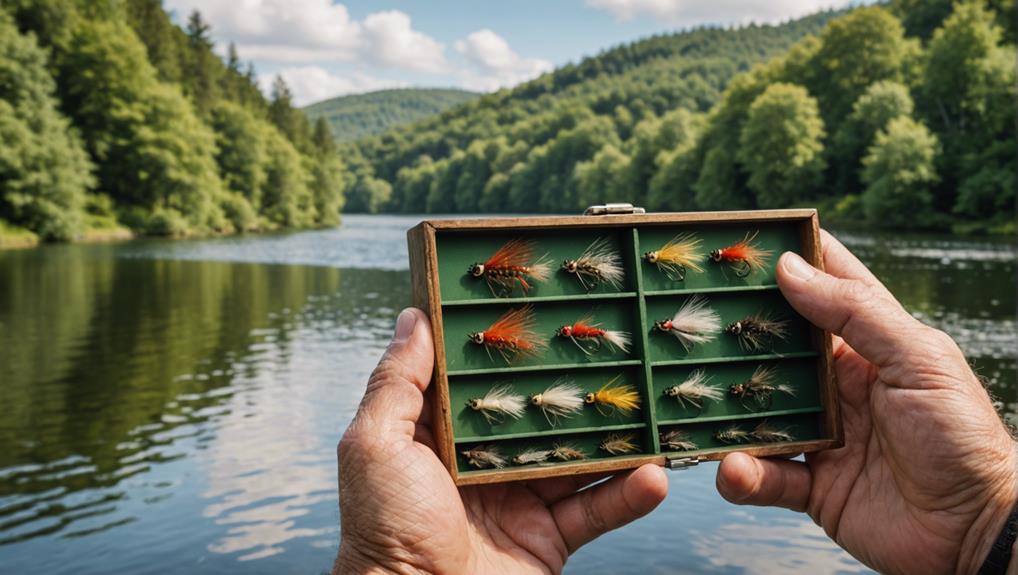In May, you’ll want to pack flies that match the frequent hatches and lively aquatic activities. Start with the Parachute Adams, perfect for mimicking mayflies, and don’t forget the Elk Hair Caddis, a top pick for surface-feeding trout. Dive beneath the surface with a Flashback Hares Ear or a Copper John nymph—both sink well and attract bites in faster currents. Lastly, spice up your arsenal with the versatile RS2 Emerger, ideal for those tricky situations where trout are picky. Each of these flies is engineered to increase your catch rate this spring. There’s a lot more to explore for achieving your best catch yet.
Key Takeaways
- Parachute Adams effectively mimics the mayfly, a common hatch in May, attracting trout with its realistic silhouette.
- Flashback Hares Ear nymph is versatile, ideal for mimicking a variety of underwater nymphs active in May.
- RS2 Emerger is effective for fishing just below the surface, matching the behavior of emerging insects during this month.
- Copper John nymph sinks quickly to reach deeper-lying trout in fast-moving spring waters.
- Woolly Bugger streamer targets aggressive trout by imitating baitfish, effective in the diverse conditions of May.
Essential Dry Flies
Typically, dry flies effectively mimic adult insects that float on the water’s surface, prompting enthusiastic trout to strike. When you’re gearing up for May fly fishing, your fly selection should include patterns like the Parachute Adams and Elk Hair Caddis. These flies aren’t just popular; they’re proven performers that match the natural appearance and behavior of local hatches. The Parachute Adams, with its versatile design, provides a realistic silhouette of a mayfly, making it essential for your tackle box during this peak season.
When it comes to presentation techniques, mastering the art of delicate casting is vital. You’ll want your fly to land gently on the water, mimicking the natural landing of an insect. This requires a refined technique, focusing on a smooth, controlled cast that allows the fly to drift naturally with the current. Avoid heavy splashes; they can spook trout and reduce your chances of a bite.
Also, pay attention to the water’s flow and wind conditions. Adjust your casting angle and strength accordingly to maintain the natural drift of your dry fly. Remember, the goal is to make your fly indistinguishable from real hatching insects, seducing trout into a strike.
Must-Have Nymphs
As you refine your fly fishing arsenal for May, consider these essential nymphs that guarantee higher success rates in attracting trout.
First up, the Lightning Bug nymph, a standout due to its curved hook and color flashes, mimics natural nymphs effectively. It’s your go-to for clear waters where trout are wary and inspection is rigorous.
Next, don’t overlook the Flashback Hares Ear nymph. This fly is a marvel in versatility, easily customized to match various nymph patterns, making sure you’re prepared no matter the conditions. Its ability to encourage strikes makes it indispensable.
The Holy Grail nymph, known for its high attraction rate, is another must-have. It’s not just its effectiveness that makes it a favorite but also its ability to imitate a wide range of nymphs, making it a versatile choice in your fly box.
For faster waters, the Prince Nymph is your ally. With its distinct profile, it’s particularly good at imitating stoneflies, a staple in the trout diet during May.
Lastly, the Copper John nymph shines in deep or fast-moving waters. Its uniform weight profile ensures it sinks quickly to where the fish are feeding, optimizing both your fly presentation and timing.
Top Emerger Patterns

After exploring the must-have nymphs, let’s focus on the top emerger patterns that are just as effective for May trout fishing. Emerger techniques are essential as they mimic the developmental stage of aquatic insects, making them irresistible to trout.
Firstly, the Barr Emerger, with its ability to imitate adult insects, is perfect for fishing just below the surface. Its design matches hatches effectively, creating opportunities for strikes as trout feed on emerging insects. When tying this fly, focus on maintaining a slender profile and use materials that provide subtle, natural movement in the water.
Next, consider the RS2 Emerger. This tailwater pattern excels by fishing as a nymph and staying level in the water, a key aspect of successful trout fishing. The fly tying secret here is ensuring the sparse tail and delicate wings are proportionate, enhancing its realistic appearance and buoyancy.
For visibility, especially in turbulent waters, tie on a Hot Wing Caddis. Its bright wing color makes it easy to spot, and the pattern is both beginner-friendly and expert-approved. Make sure the wings are tied at the correct angle to mimic the natural wing shape of adult caddisflies, boosting its effectiveness.
Utilizing these emergers will greatly enhance your trout fishing success in May, ensuring you’re prepared for various hatching scenarios.
Effective Streamers
Switching gears to streamers, you’ll find that patterns like the Woolly Bugger are incredibly versatile, adeptly mimicking baitfish to provoke aggressive strikes from trout. As you explore deeper into streamer techniques, consider the Sculpin patterns, which are stellar for targeting trophies lurking in deep pools. Their realistic profile and slow, enticing movements make them irresistible to larger, more cautious trout.
Investigating further, the Zonker streamer, with its rabbit strip design, thrives in fast currents. Its unique, pulsating action simulates a vulnerable baitfish, perfect for tempting big trout that are typically hard to fool. When you’re casting in these swift waters, make sure your retrieval speed keeps the Zonker lively yet believable.
Don’t overlook the Clouser Minnow for its exceptional diving action. It’s not just effective in saltwater; its ability to imitate an injured baitfish makes it a top choice in freshwater scenarios too. Pair this with a jerky retrieve to enhance its effectiveness.
Lastly, the Muddler Minnow shines in murky conditions. Its natural appearance and buoyant design stir up underwater commotion, ideal for triggering aggressive strikes. This fly’s versatility in various water conditions makes it essential in your arsenal for May trout fishing.
Choosing the Right Fly

While exploring effective streamers is beneficial, choosing the right fly involves considering the specific conditions and what trout are feeding on in May. You’ve got to assess both the fishing conditions and the weather. If it’s a cooler May, trout mightn’t be as active, and you’d do well with nymphs that mimic the invertebrates they’re munching on under the surface.
Fly selection becomes important as you match the hatch; understanding trout behavior and their diet during this month can greatly tip the scales in your favor. Trout are often on the lookout for emerging insects, so flies that can imitate these natural occurrences will enhance your success rates. Consider using patterns like the Mayfly nymph or emergers that are prevalent during this time.
Frequently Asked Questions
What Trout Flies to Use in May?
In May, you’ll want to select trout flies that match the river conditions and hatch patterns. Opt for Lightning Bug, Woolly Bugger, and Elk Hair Caddis to increase your chances of success.
What Is the Most Successful Fly for Trout?
The most successful fly for trout depends on current conditions. You’ll find experimenting with various fly materials and catching techniques essential. Keep track of what works best in different scenarios to optimize your success.
What Are the Best Flies for Spring Trout?
For spring trout, you’ll find that matching hatches and considering water temperature impacts are key. Try Parachute Adams, RS2 Emerger, and Pheasant Tail Nymph for effective results in various conditions.
What Is the Easiest Fly to Catch Trout On?
The easiest fly to catch trout on is a basic nymph like the Pheasant Tail. Mastering fly tying techniques and understanding seasonal hatch variations will greatly enhance your success in various fishing conditions.
Conclusion
Now that you’ve got the rundown on the top trout flies for May, you’re well-equipped to hit the rivers.
Remember, choosing the right fly is about understanding what trout are feeding on at a specific time and place. Whether it’s a dry fly, nymph, emerger, or streamer, your selection can make all the difference.
So, tie one on, cast your line, and get ready for some exciting strikes. Here’s to tight lines and bountiful catches this season!